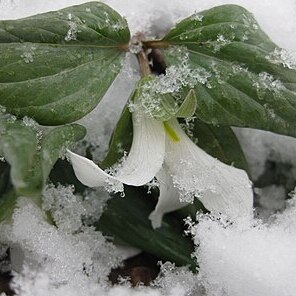Rhizomes short, praemorse. Scapes usually 1, 6-gonal in cross section, 0.3–0.5 dm at onset of anthesis, expanding to 0.45–0.8 dm, slender, glabrous. Bracts distinctly petiolate; blade bluish green, elliptic-ovate to ovate, 1.5–4.5 cm × 0.7–34 mm, base abruptly rounded to petiole, apex round-obtuse. Flower erect, fragrance sweet; sepals spreading, flat, bluish green, lanceolate, 10–32 × 2–7 mm, shorter than petals, margins entire, apex obtuse; petals very showy, recurved to erect-spreading, white, veins not engraved on adaxial surface, ovate-elliptic to oblong, 1.5–3.5+ × 0.8–1.5 cm, thin-to firm-textured, margins entire to slightly wavy, apex obtuse-acuminate; stamens straight, 5–18 mm; filaments white, slightly shorter than anthers, slender; anthers straight, pale yellow, 2.5–11 mm, thin, dehiscence introrse; ovary greenish white, ± globular, obtusely 3-angled; style with tips spreading, elongate, 0.5–1.5 mm, slender; stigmas prominent, recurved or curled, connate basally, white, linear, threadlike, 4–12+ mm; pedicel erect in anthesis, rapidly recurving below leaves after pollination, 5–20 cm. Fruits greenish white, odorless, globose-ovate, 0.6–1 × 0.5–0.8 cm, pulpy, not juicy. 2n = 10.
More
Diminutive; stem 8–15 cm at anthesis; lvs elliptic to lance-ovate or ovate, at anthesis 3–5 cm, acute or usually obtuse, rounded at base to a petiole 5–10 mm; peduncle ± erect, 1–3 cm, recurved in fr; sep lanceolate, much shorter than the pet; pet white (sometimes pinkish at base), elliptic or elliptic-obovate, 2.5–4 cm, obtuse; anthers 7–10 mm, somewhat exceeding the slender filaments; ovary subglobose, roundly 3-lobed. Rich moist woods; w. Pa. and W.Va. to Minn., s. S.D., w. Nebr., and Mo. Mar., Apr.


